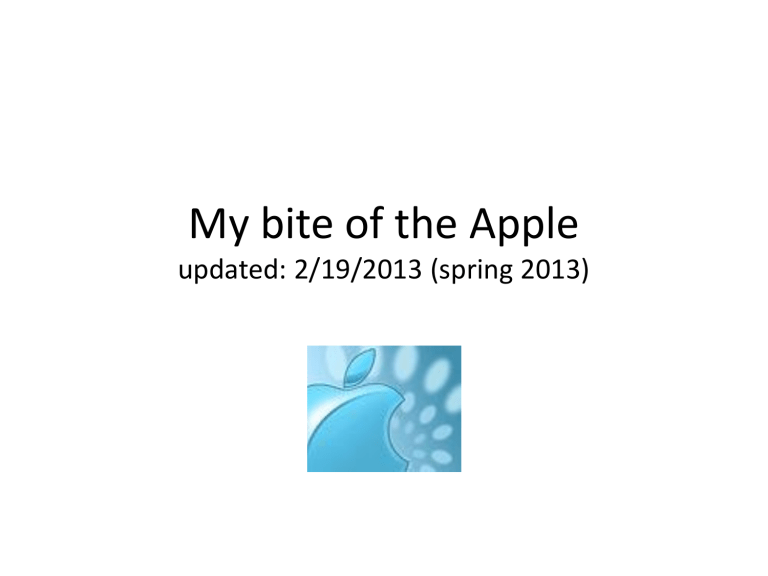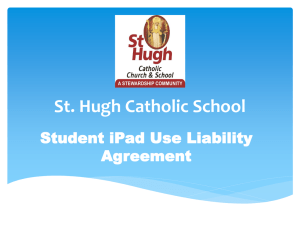A bite of Apple - College of Business

My bite of the Apple updated: 2/19/2013 (spring 2013)
The Outline
1. The theme(investment highlights)-Great company,
Cheap price.
2. Business analysis
3. Financial analysis
4. Stock valuation
5. The moat
6. Risk
7. Bulls vs. bears
8. Investing strategies
Investment Highlights-the theme
--
A growth stock with a moat, sold at deep discount.
• Ecosystem: Ever expanding ecosystem with high switching cost, halo effect and network effect. With the increasing user base every day, Apple is expected to have more than 1 billion installed user base, and 500 million annual sales of iOS devices by 2016. The mass creates enormous gravity to capture and keep existing and new customers. Software is the soul of Apple products and it helps to migrate users from one generation of hardware to next generation.
Its unique OS allows the company to differentiate from its competitions and avoid brutal price war common to consumer electronics.
• Asset light model and High FCF conversion ratio: Apple’s FCF almost equates its NI. The business does not need substantial fixed assets, and its working capital is self-sustained by its net Accounts
Payable. Inventory turnover almost 200X in 2012, Net FA only 10% of sales. Apple can convert almost 100% of its income into FCF.
Investment Highlights
• Foreseeable Growth: potential high growth until 2016
with current product lines. Although the total size of the company is huge, in the three major segments it operates, it either has a small market share in the biggest and growing markets ( smart phones ), small market share in a big market (PC), or high market share in a growing market (tablets). The growth potential in all three segments are still high.
• Innovation: There might be next big thing like iTV. The next big thing is not priced in our valuation model, it would be a bonus if it materialize.
Investment Highlights
• Conservative accounting: Extra tax reserves for unpaid overseas earning tax (10% of EPS).
Share-based compensation understate EPS.
• Cash: Piling cash balance and low interest earned on it. Company has a good track record of not wasting money on acquisition. It will payout as increasing dividends and buybacks, special dividends, or interest earned on higher interest rate after 2014.
Investment Highlights
• Risk: New disruptive technology, fierce competition(google, Samsung), management shuffle, competitive relationship with partners are the major risks. Sales could significantly slow down after 2016 without new revolutionary products. Sales growth is already slowing and we might see first quarter of significant EPS decline for March 2013.
Investment Highlights
• As of 2/19/2013, the market stock price is around
$450, and we believe its fair value is around $700 .
• Considering its potential growth in next 5 years, continuous growth from innovation in the long term, and rich free cash it has accumulated and continue to generate, it is still very cheap with a 10- PE.
• AAPL has been a very volatile stock for the last five years and will continue to be. The combination of its risk and return offers great opportunity for patient investors who buy growth at value price.
• Recommendation: BUY
• Disclaimer: this is an example of stock analysis for educational purposes. The professor is not endorsing any stock in this class.
Business Analysis-Macro Economy
• The state of our economy (also see separate slides).
• The state of the overall stock market.(see stock history)
• The impact of slowing economy on AAPL
– products
• Products sold at premium price would suffer
• Some purchases will be postponed, but not discarded
• Innovative products at its early life cycle will still grow
– Financial strength
• A strong balance sheet with enough cash is an important competitive advantage
Business Analysis-Industry Analysis
• See separate slides for smart phone and PC industry analysis
Business Analysis-The Products
• Overview: Segments, size, market share and growth.
– Mac (hardware and software): 14M units ,4% PC share; 30+% growth,
3 times industry average. Down to single digits during recession.
Rebounded to 32% growth in 2010.
– iPod (also iTune, and accessories): 50M units, 70% US market, negative growth. Down 7% June09 Q , first decline since introduction. Will decline at 10% rate
– iPhone: 10M + units 2008, 20M 2009, 40M 2010. huge growth potential, might reach 100M in 2013, and 150M 2015. The King of the iEmpire.
– iPad: 10M first year of introduction, 20M 2011, 50M 2015
Business Analysis-The Products-iPad
• Tablets Demand-why users want it?
• When
– Travel, at home or in class
• What
– Web
– Video (youtube, Netflix, iTune, Hulu)
– Ereader, enhanced books, textbooks (interactive features)
– Create documents
– Other: games, music
• More for individual than for business use(?).
– Realtor, Spaceship
– Conferences
Business Analysis-The ProductsiPad
• Tablets Demand-more on e-textbook
– The rising e-textbook tide
• Publishers are embracing e-textbook at a very fast speed. In fact, many text books now have a e-version
• E-textbook has very little marginal cost
• E-textbooks are not resalable (unlike used books, publisher and authors always get paid)
• E-textbooks offer interactive features for homework and exams, and many more.
– A hardware is needed, cheap and capable. (iPad?)
Business Analysis-The ProductsiPad
• Tablets Demand-Addressable Market
• Tablet offers portability and size that is between PC and smart phone
• Tablet is a complement of PC, not a replacement(?).
• The addressable market is big in absolute size
(150million users), but smaller than PC (1 billion user)
• Annual sale will be around 50 million units in 5 years
• Pending demand is high
Business Analysis-The ProductsiPad
• Potential Supply (tablet industry)
– PC makers (HP, Dell, Acer..)
– Smart Phone makers (NOK, Samsung)
– Ereader (Sony, AMZN)
Business Analysis-The ProductsiPad
• Post iPad launch and the users
– Users love their iPads
– 3.2 Million sold in June Q
– Production cannot meet demand
Business Analysis-The ProductsiPad
• Post iPad launch and the tablet industry
– The surprise
• $500 is a bad surprise for competitors
• iPad an extension of phone OS, not Mac OS
– Always on, long battery, not Hot!
– The Consequence
• HP, Microsoft’s failed first strike
• Delayed launch of other tablets
• E-reader price war
– Current competition (Lenovo, Dell, Android)
– Future competition
Business Analysis-The Products-iPad
• How WinPad can win?
– Match features
• Price
• OS: Win 7 mobile OS, system always on, no starting time
• Battery
• Form-weight, thickness
• Apps
– Differentiate
• MS Office, Flash
• Connections with other devices, print
• Different forms (7”, 5”, 11”..)
Business Analysis-The ProductsiPad
• iPad
– Strength<?>
• Apps
• Price-$499
• Battery-10 hours
• iPhone OS: easy to start, always on, low consumption of power
• Fast, no virus, no pop ups, no frozen screen
– Weakness<?>
• No openness (store files, play video and music from other sources)
• No Flash
• No real keyboard
• No MS office
Business Analysis-The ProductsiPad
• iPad sales, profitability and stock value added
– Commands 30-50% share of tablet market
– 6 million units for fisical 2010 (twice the units of all kindles sold so far), 20 mil 2012 .
– Gross Margin: 35%
– iPad standalone stock value: $45 B, or $48/share
• Sales=$600*20M=$12b
• Operating Profit: 12*35%=$4.2b Net Profit:
4.2*70%=$3b
• Assuming PE=15 3*15=$45b market capitalization
Business Analysis-The Products-iPhone
Quick survey
– satisfaction
• Smart phone ownership and satisfaction
• iPhone ownership and satisfaction
• Other smart phones satisfaction
– Plan to buy
• Buy iPhone
• Buy other smart phones
– Why like iPhone?
– Why not?
Business Analysis-The Products-iPhone
Strength
– Non-defendable
– All-in-one pocket device
– Full screen
– Touch (vs. keyboard, tracking ball…), (Win vs. Dos), important for applications (calculator, etc..)
– Ease of use
– An evolving phone: your phone gets better without hardware upgrade
– Defendable
– The brand (innovative, cool, high quality, premium brand)
– Multi-touch:
– Critical for small screen device, great for internet
– Protected with patent, challenged by Palm Pre, and more challengers to come. Just sued HTC, and
Google could be next
– App store
– iTune Ecosystem: (medium file manager and on-line store)
Business Analysis-The Products-iPhone
Weakness
– Real issue
– A closed system
– The exclusive carrier: smart decision or not?
– The data fee: an opportunity for a no-data fee competitor?
– Non-issue
– The battery: not enough for a heavy duty day
– The keyboard: Need hepatic feedback?
– The device price
– The features: what should be included and what should not?
– Weakness from your user experience
Business Analysis-The Products-iPhone
• The iPhone-competition
– Competition: Is the “Storm” coming? Is it time for “Dream”?
– New Entry:
• Traditional phone makers
• Smart phone only makers
• New comers
• PC guys: Dell, HP, Lenovo, Acer
– Create and continue dominance like iPod? Or fade away like Mac before
– Possible outcomes of smart phone industry
• Co-existence of several major brands, hardware and platforms
• A dominant player (winner takes all)
• A universal operating platform ( Google, WinMobile)
– Projection of smart phone industry market share in 5 years
Business Analysis-The Products-iPhone
• The iPhone: sustainable competitive advantage
– Strategic Strength
• Strength
– Software and applications: smart phones will be software centered
– Hardware: a fashion statement
– PC expertise: the phone feature is less important, and the computer features are the differentiator
– The App store and iTune
– The brand
– The customer loyalty: the highest among competitors, always
– The focus and economy of scale
Business Analysis-The Products-iPhone
Strategy
• It is the software!
– Old game (hardware) vs. Apple (Software)
– I don’t see new form factor in the near future
• Using App Store to distinguish from competitors
– Get iPhone/iTouch to mass market
– Making development tools easy to use
– More App, less in-house software
• Using iTune content to distinguish ..
Business Analysis-The Products-the Mac
Strength
– Software
» Relatively free from most viruses
» Fast speed
» Most applications are free
– Hardware
» Design driven (first all-in-one design)
– First to see the desktop to laptop trend
– Strong brand in US, especially college
( Hollywood?)
Business Analysis-The Products-the Mac
• Weakness
– Software
» Win compatibility, pose long term threat
» Lack of applications
– High price
– Less brand recognition outside US, especially developing countries
– Penetration in business not successful
Business Analysis-The Products-the iPod
• Strength
– iTune, a ecosystem, a plat form, not just device
– First mover advantage
– Brand,Design
– Economy of scale(cost),Marketing
• Weakness
– Does not own content
– Too strong brings too many enemies ( studios-NBC, digital distributors-Amazon, device maker-Microsoft, Dell)
– Low bar of entrance (digital retailer is easy to start)
– Converging to converged device ( the phone)
– Market Saturation
Financial Forecasting
– Top-down product driven approach
• Sales
– Revenue driver
– Market share: (Too big to grow)
– Units
– Average Selling Price (declining ASP)
Financial Forecasting
– Sales:
I expect sales to double in three years ( from Sept 2011 to Sept 2014)
• Units: sales will be driven by iPhone and iPad. iPhone from 70M+ to 250M+, iPad from 30M to 80M+, Mac from 15M to 30M
• Market share: iPhone 30%(smart phone share), iPad 40%, Mac
6.5%
• ASP:
– ASP for consumer electronics and PC declines over time in general, due to lower component cost and competition
– Apple is good at NOT competing on price by differentiation.
– Still, Apple product price follows a downward trend
Financial Forecasting
• Profits and margins: from top line to bottom line
– Gross margin
• Competition will force price cut and reduce margin
• Component cost declines over time
• Higher revenue and big orders of components give apple increasing bargaining power on component cost
• the changing mix of high margin vs. low margin products
• Labor cost might rise
– Operating margin
• Economy of scale. Fixed cost is fixed, average cost down, Net income increases faster than sales and expense/sales ratio down over time
– Profit margin
• Interest, Tax
Financial Forecasting
• EPS
– EPS=Net Income/Number of shares outstanding
– Number of shares: SEO, normal Dilution, option grants
Stock Valuation
• FCF model
• PE approach
• Forward PE
• Five year super growth P/E model
– Simple and useful
– Financial forecasting beyond five years is of little value
– Five year super growth: growth will eventually slow down due to competition and rule of big numbers
– Assuming industry average P/E in five years
Stock Valution
• Free Cash Flow(FCF) model
– Consider FCF as the theoretical dividend that can be paid
– It works like a two stage dividend growth model
Stock Valuation
• Sensitivity Analysis
– Future=uncertainty
– Output depends on inputs and model
– Map possible inputs and output (price)
The moat
• Definition of moat:
– Long term sustainable competitive advantage. A defense of your profit castle from invaders.
– Wide: The company still owns the market if it stands still for five years
– Narrow: The company can stay ahead of its competition if it keeps moving faster than competitors
– None: The company can be outpaced by competition any time
• Components of moat: cost advantage, Switching cost, network effect, intangible assets(exclusive right, patent, brands)
• Google, Facebook, MSFT,NFLX,Railr oad, Utility
The moat: Apple-
Narrow but growing
• Cost advantage: narrow
– One model, one color, hundreds of millions in volume
– In fast pace industry like tech, cost advantage is a very narrow moat (HP, Dell, NOK)
• The brand commands premium, and enjoys loyalty
– Q: who is willing to pay premium for those brands?
• AAPL, Dell, SONY, Tiffany
• The innovation is not a one-time wonder
– Apple II, Mac OS, iPod, iPhone, iTune, App store
– But the innovator might be gone
The moat: Apple-Narrow but growing
• Is there a switching cost?
– In class survey: how much $ to make you switch?
– iOS: Users do not want to switch OS. There is a time cost of learning.
– Information(calendar, contacts..) difficult to export to another platform, but easy to synch with next generation of iPhone. The soul of your phone never dies, it revives with a new body(next genration)
– Apps: they cost money, contain personal data(1password, notes, iBook), progress of games and won’t work on other
OS.
– Content: music/video/books purchased from iTunes with protections.
The moat: Apple-Narrow but growing
• Network effect:
The value to individual users increases as more users use the product/service.
– the more users of iOS, the more developers, the more Apps and the more users. It is a good cycle, like a rolling snow ball.
– iMessage
– Facetime, Game center
The risk
• Competition: AAPL is not Microsoft at any fronts it competes.
– Enemies:
• Enemy number 1: Google. Competes with AAPL on mobile OS, Tablets, internet TV, and possibly music.
• Enemy number 2: Microsoft
• Smart phone family: NOK, MOT, HTC, Samsung, RIMM
– Price and margin pressure
• Leadership
– Tim is a great operator, coordinator, manager, but not a “product person”, not a “marketing genius”, not a visionary
– Power struggle within and Apple might lose talent
– Lack of ultimate authority to do the “right” but unpolular thing
The risk
• Disruptive technology: Web-based app and html5
• Double Recession: slower growth of high end products
• Regulation: not a big concern as Soft or Intc, but a growing concern
• Quality issue, product failure
– iPhone5 Map gate
– Antenna gate for iPhone4.
– Explosive iPod in Japan
– White iPhone delay
• Lawsuit: patent lawsuit banned it from delivering smart phones.
risk
• Labor issues: Apple face negative publicity for the unfriendly working conditions and low pay of its supply chains. Labor cost will rise sharply and might lower gross margin.
• Brand : the brand might be diluted when Apple lower prices and go mainstream.
• Relations with carrier and subsidies. Once carriers decide to cut subsidy significantly, Apple might lose volume, ASP and margin same time, cause a decline of profit
• Tax: Tax of cash parked in foreign subsidiary when they are repatriated to
US ultimately. Apple might not only need to pay US tax on these cash, but its effective tax rate on future earnings would eventually rise to 30% + level, lowering its earning power significantly.
Bulls vs. Bears
The Bear
• Too big: AAPL has a market cap higher than Soft, and the only direction from top is going down.
• Valuation: Current valuation is still high, compared with Soft and Intc.
• Android: Competition like Android is catching up
• Margin: Margin might collapse because of competition
• Growth: Growth will slow down. Rule of big numbers.
• Double dip
Bulls vs. Bears
• The Bull
– iPhone and iPad revolution, just the beginning.
– The halo effect
– The moat
– The vision and innovation into a different industry.
– FCF conversion, Large cash reserve
– Valuation still low
Investing Strategy
• Ladder Approach
– Buy at 20% discount
– Overweight at 30% discount
– Leap call option at 40% discount
– Short term call options at 50% discount
Notes
-new developments since spring 2010
• iPad sales exceeded expectation by wide margin
• Antenagate
• 2010March and June Q exceeded expectations




